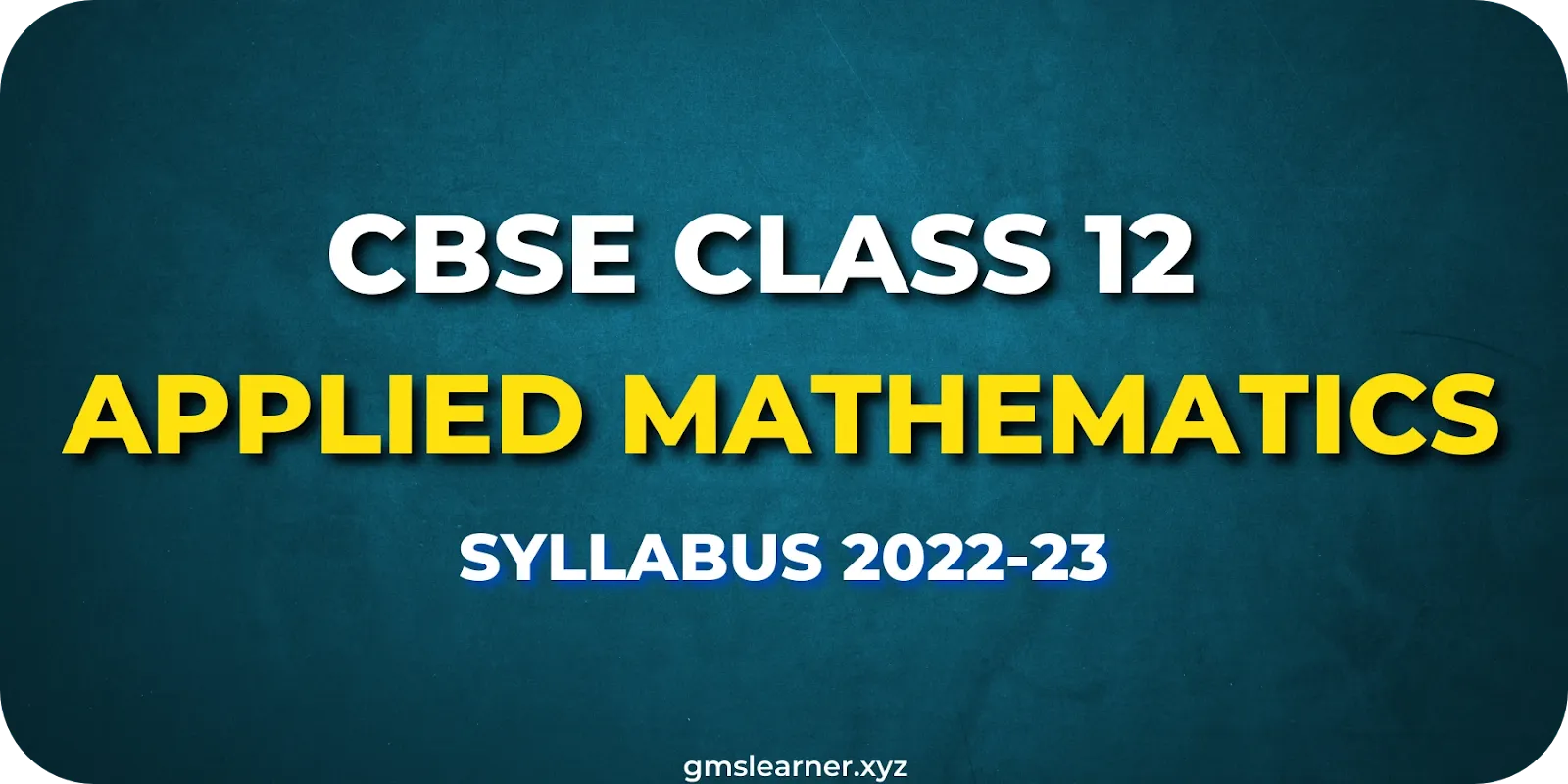CBSE Class 12 Applied Mathematics Syllabus 2022-2023 can be downloaded from here in PDF. Follow this revised syllabus to prepare for your school and board exams to be held in the 2022-2023 session.

Check the CBSE Class 12 Applied Mathematics Syllabus 2022-2023 here. This is the revised syllabus that has been released by the Central Board of Secondary Education (CBSE) for the current academic session. Students must consider the reduced syllabus and prepare only according to the content mentioned in it. CBSE Class 12 students can download the CBSE Class 12 Applied Mathematics Syllabus 2022-2023 from the link provided below in this article.
Check CBSE Class 12 Applied Mathematics Syllabus 2022-23 below:
Number of Paper: 1
Total number of Periods: 240 (35 Minutes Each)
Time: 3 Hours
Max Marks: 80
| No. | Units | No. of Periods | Marks |
|---|---|---|---|
| I | Numbers, Quantification and Numerical Applications | 30 | 11 |
| II | Algebra | 20 | 10 |
| III | Calculus | 50 | 15 |
| IV | Probability Distributions | 35 | 10 |
| V | Inferential Statistics | 10 | 05 |
| VI | Index Numbers and Time-based data | 30 | 06 |
| VII | Financial Mathematics | 50 | 15 |
| VIII | Linear Programming | 15 | 08 |
| Total | 240 | 80 | |
| Internal Assessment | 20 |
Check CBSE Class 12 Syllabus of All Subjects for 2022-2023 Session (PDF)
CBSE Class 12 Applied Mathematics Course Content 2022-2023:
| S. No. | Contents | Learning Outcomes: Students will be able to | Notes / Explanation |
| UNIT-1 NUMBERS, QUANTIFICATION AND NUMERICAL APPLICATIONS | |||
| 1.1 | Modulo Arithmetic | ● Define modulus of an integer · ● Apply arithmetic operations using modular arithmetic rules | ● Definition and meaning Introduction to modulo operator ● Modular addition and subtraction |
| 1.2 | Congruence Modulo | ● Define congruence modulo ● Apply the definition in various problems | ● Definition and meaning ● Solution using congruence modulo ● Equivalence class |
| 1.4 | Alligation and Mixture | ● Understand the rule of alligation to produce a mixture at a given price ● Determine the mean price of a mixture ● Apply rule of alligation | ●Meaning and Application of rule of alligation ●Mean price of a mixture |
| 1.5 | Numerical Problems | Solve real life problems mathematically | |
| Boats and Streams (upstream and downstream) | ● Distinguish between upstream and downstream ● Express the problem in the form of an equation | ● Problems based on speed of stream and the speed of boat in still water | |
| Pipes and Cisterns | ● Determine the time taken by two or more pipes to fill or empty the tank | ● Calculation of the portion of the tank filled or drained by the pipe(s) in unit time | |
| Races and Games | ● Compare the performance of two players w.r.t. time, distance | ● Calculation of the time taken/ distance covered / speed of each player | |
| 1.6 | Numerical Inequalities | ● Describe the basic concepts of numerical inequalities ● Understand and write numerical inequalities | ●Comparison between two statements/situations which can be compared numerically ●Application of the techniques of numerical solution of algebraic inequations |
| UNIT-2 ALGEBRA | |||
| 2.1 | Matrices and types of matrices | ● Define matrix ● Identify different kinds of matrices ● Find the size / order of matrices | ● The entries, rows and columns of matrices ● Present a set of data in a matrix form |
| 2.2 | Equality of matrices, Transpose of a matrix, Symmetric and Skew symmetric matrix | ● Determine equality of two matrices · ● Write transpose of given matrix · ● Define symmetric and skew symmetric matrix | ● Examples of transpose of matrix ● A square matrix as a sum of symmetric and skew symmetric matrix · ● Observe that diagonal elements of skew symmetric matrices are always zero |
| 2.3 | Algebra of Matrices | ● Perform operations like addition & subtraction on matrices of same order ● Perform multiplication of two matrices of appropriate order ● Perform multiplication of a scalar with matrix | ● Addition and Subtraction of matrices ● Multiplication of matrices (It can be shown to the students that Matrix multiplication is similar to multiplication of two polynomials) ● Multiplication of a matrix with a real number |
| 2.4 | Determinants | ● Find determinant of a square matrix ● Use elementary properties of determinants | ● Singular matrix, Non-singular matrix ● |AB|=|A||B| ● Simple problems to find determinant value |
| 2.5 | Inverse of a matrix | ● Define the inverse of a square matrix · ● Apply properties of inverse of matrices | Inverse of a matrix using: a) cofactors If A and B are invertible square matrices of same size, i) (AB)-1=B -1A –1 ii) (A-1)-1 =A iii) (AT ) -1 = (A-1 ) T |
| 2.6 | Solving system of simultaneous equations using matrix method, Cramer’s rule | ● Solve the system of simultaneous equations using i) Cramer’s Rule ii) Inverse of coefficient matrix ● Formulate real life problems into a system of simultaneous linear equations and solve it using these methods | Solution of system of simultaneous equations upto three variables only (non- homogeneous equations) |
Download the full syllabus from the link provided below: